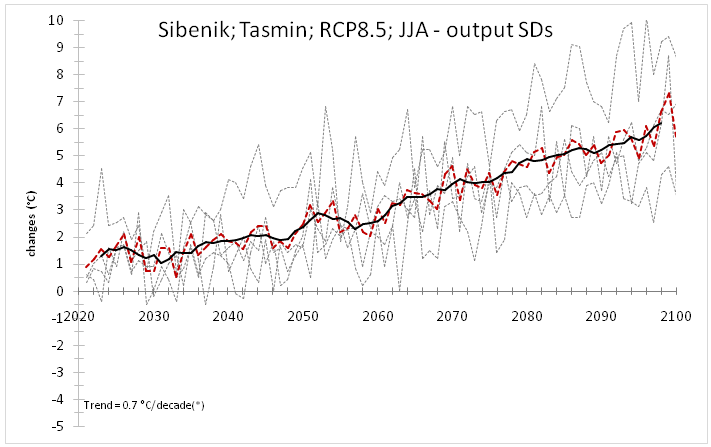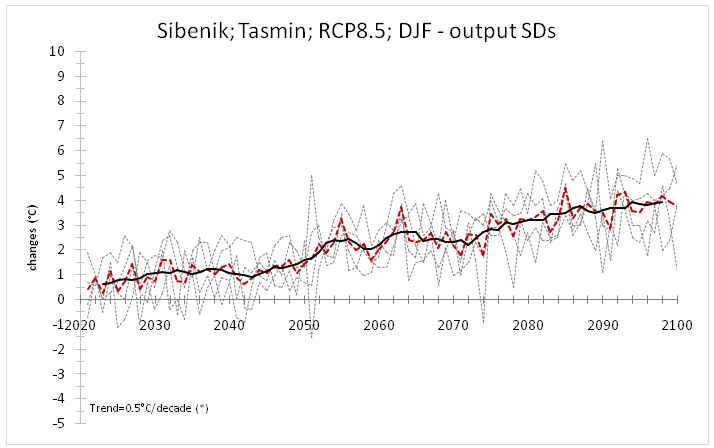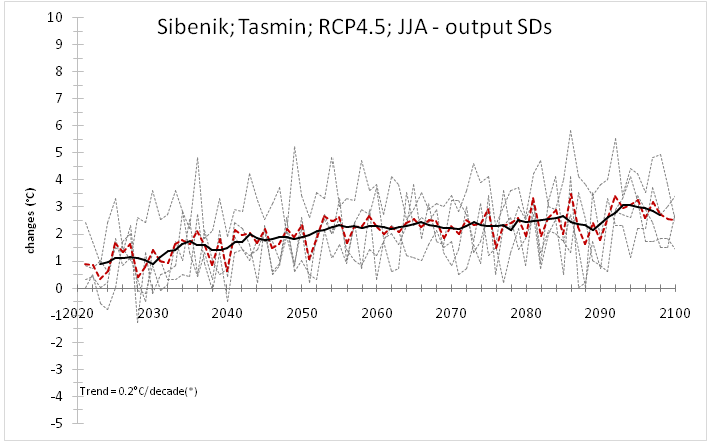Šibenik
Climate change projections for Šibenik with special emphasis on severe
impacting events
Authors: CMCC, ARPAE, DHMZ
contact person: enrico.scoccimarro@cmcc.it
Expected climate change for Šibenik pilot area
Expected climate change presented in this short document is the summary of the ADRIADAPT D.3.3.1 document – Climate change projections for Šibenik with special emphasis on severe impacting events. For more information on the data used, processing and analysis methods, graphical representations of the results and conclusions, we advise to look at this document.
1.1 Dynamically downscaled
In this section, we present future climate change of temperature and precipitation related indices, surface relative humidity and extra rare perceived temperature projections for Šibenik. All indices are calculated from the four available regional climate models for the model point representing the location of Šibenik. Data set is obtained by interpolation of data from neighbouring points. Data are presented as follows:
- Climate change diagram of an individual index in seasons: DJF standing for the months of the winter season, MAM for the months in spring, JJA for the summer months, and SON representing the autumn months. Data is presented furthermore and on annual basis for four future periods: 2021-2040, 2041-2060, 2061-2080 and 2081-2100 and for two emission scenarios: a moderate one called also stabilization scenario (RCP4.5) simulating a future world where considerable efforts have been put into mitigation policies and a high-emissions climate scenario (RCP8.5, often called pessimistic climate scenario) which simulates a future world without climate mitigation policies. We calculated indices representing the difference between present and future climate (called also future anomalies or changes). Reference period is 1985-2006 and a star marks such values for which changes are statistically significant.
- Time series of the future anomaly (or changes) of an individual index for the winter (DJF) and summer season (JJA) for RCP4.5 and RCP8.5 emission scenarios. Anomaly is calculated concerning the reference period and shown for the individual models, the mean and the 5-year average. Statistical trend test is applied to the ensemble mean (for 95 % confidence level). A significant trend is marked with a star (ns if not significant).
1.2 Statistically downscaled
In this section, we present future climate changes of temperature and precipitation related indices for Šibenik, simulated by the statistical downscaling techniques set-up on the observed local data/observed large scale circulation patterns and then applied to the future large-scale circulation patterns simulated by four models. The results are presented as follows:
- Climate change diagram of an individual index for each season and on annual basis for four considered future periods: 2021-2040, 2041-2060, 2061-2080, 2081-2100 and the two emission scenarios (RCP4.5 and RCP8.5). Anomalies or future changes are calculated as a difference between future and reference period for temperature indices and some intense precipitation indices, and as their relative differences (expressed in % for precipitation). The reference period (noted as Ref. mean or obs.) is 1986-2005, the climate observed value is the one registered at the meteorological station, while the values for the different periods in the future are shown for the different climate models as well as for the ensemble mean of those models (ENSMEAN). A statistical test is applied to test the significance of future climate change with respect to the present climate value. The results considered as significant are marked by a star.
- time-series of a future anomaly of an individual index for winter and summer and for two emission scenarios; the anomaly is calculated with respect to the reference period and shown for individual models, the ensemble mean and 5-year moving average. A statistical trend test is applied to the ensemble mean. A significant trend is marked with a star (n.s. if not significant).
2 Temperature related data
2.1 Results from dynamical downscaling (DD)
2.1.1 Averaged 2 meter air temperature
Averaged temperature change in Šibenik shows an increase on an annual scale as well as for single seasons, for all future periods (winter is an exception for two models in the near future). Although each model gives a different amplitude of change, in the ensemble mean the change is highest during summer and smallest in winter, for the moderate climate scenario. The temperature increase is more pronounced towards the end of the century with an increase of mean temperature of 1.4 °C in winter and 2.2 °C in summer. On an annual scale for the moderate scenario temperature increase is for 1.7 °C. The amplitude of temperature change is more pronounced for high-emissions climate scenario, reaching on annual scale 3.6 °C by the end of 21st century, 3.0 °C in spring and 4.4 °C in summer. The linear trend of temperature anomaly (Figure 1) in the future shows an increase which is statistically significant for both considered seasons and both the moderate and the high emission scenario; in winter it is 0.19 °C per decade for the moderate climate scenario and 0.54 °C per decade for the high-emissions scenario; in summer 0.18 °C per decade for the moderate climate scenario and 0.52 °C per decade for the high-emissions scenario.

Figure 1: Variability of future 2m air temperature anomaly (in °C) in Šibenik for 2021-2100 obtained by dynamical downscaling for winter (DJF) and summer (JJA) and two emission scenarios, moderate (RCP4.5) and high-emissions (RCP8.5): individual models are in grey, the ensemble mean in red, 5-year moving average in black. A significant trend is marked with a star (ns if not significant).
2.1.2 Extreme high temperature
Extreme high temperatures (defined as 99th percentile of 2m air temperature) in Šibenik are increasing. At the end of the century, for the moderate scenario, the warming ranges from 1.0 °C in winter to 2.6 °C in summer, and by 2.6 °C in an annual mean. For the high-emissions scenario, the amplitude of temperature rise is as high as 4.7 °C for annual change at the end of the 21st century. And that is even more pronounced when the maximum temperature is examined.
2.1.3 Extreme high maximum temperature
The change of extreme high maximum air temperature in Šibenik (defined as 99th percentile of 2m maximum air temperature), is increasing from first to last future periods with the different amplitudes for each model and season. At the end of the century, the change of extreme high maximum temperature ranges from 1.1 °C in winter to 2.8 °C in autumn, 2.6 °C on the annual scale for moderate climate scenario. The amplitude of change is more pronounced for high-emissions climate scenario and is between 3.0 °C in winter and 5.1 °C in autumn, 4.7 °C for annual change at the end of 21st century.
2.1.4 Extreme rare high temperature
Future change of 99.9th percentile of 2m air temperatures (extreme rare high temperature) in Šibenik is increasing towards the end of the century with the different amplitudes for each model. A slightly negative change appears for some seasons and some models for the periods until 2060, but the average change is positive for all periods. At the end of century increase is on annual scale 2.6 °C for moderate climate scenario and 4.5 °C for high-emissions climate scenario.
2.1.5 Extreme rare high maximum temperature
Analysing the future change of extreme rare high maximum temperature (defined as 99.9th percentile of 2m maximum air temperature) in Šibenik, we came to the same conclusion. Some models show for some time slices small negative change, but in general, the ensemble mean for all seasons and annual change are positive ranging up to 5.2 °C in autumn at the end of 21st century within the high-emissions climate scenario.
2.1.6 Extra rare humidex projections
The change in extra rare humidex (defined by 99.9th percentile of humidex) which now occur very rarely, only 10 times in 30 years, will slightly increase in Šibenik towards the end of the century. The ensemble mean for the moderate climate scenario shows the biggest increase in spring (up to 2.2), and for the high-emissions scenario, it is highest in autumn (5.8). The relative change on an annual scale is 1.3 for moderate and 4.4 for pessimistic scenario. Variability shows a positive linear trend for both seasons and both considered scenarios and the trends are statistically significant.
2.2 Results from statistical downscaling (SD)
2.2.1 Seasonal minimum and maximum temperature
The future projections show possible increases in seasonal minimum and maximum temperature from first to last future period and, both emission scenarios. Following the moderate scenario, we expect an increase in annual minimum temperature of 1 °C during the first period (2021-2040) and up to 2 °C to the end of the century. The projected increase in annual minimum temperature is higher for high-emissions climate scenario, especially for the last two future periods, when the simulations show changes up to 4 °C. Analysing in details the seasonal projected changes of minimum temperature, summer season shows a higher magnitude of changes, up to 5.5 °C in high-emissions scenario towards the end of the century. The long-term variability of projected changes represented in Figure 2 shows positive and significant trends, more intense for pessimistic climate scenario and especially in summer, about 0.7 °C/decade.
As regards maximum temperature, following the moderate RCP4.5 scenario we expect an increase in annual maximum temperature between 0.9 °C during the first period (2021-2040) and up to 2.0 °C going to the end of century (2081-2100). The projected increase is higher for RCP8.5, especially for 2061-2080 and 2081-2100 when the simulations show changes in annual maximum temperature about 2.9 °C and 3.9 °C, respectively.
Seasonally, the projected changes of maximum temperature show possible increases from the first to last future period, with higher magnitude during spring when could reach about 2.3 °C for RCP4.5 and 4.4 °C for RCP8.5 at the end of century (2081-2100). Intense changes have been projected also during spring and autumn for RCP8.5.
2.2.2 Extreme temperature: 5th percentile of minimum temperature and 95th percentile of maximum temperature
Extreme temperature reveals important future changes at Šibenik meteorological station. An increase in annual 5th percentile of minimum temperature of 0.7 °C is projected during the first future period and up to 1.7 °C to the end of the century, in the framework of moderate emission scenario. The signal is more intense for high-emissions scenario and especially during 2061-2080 and 2081-2100 periods, when the annual increases could reach 2.5 °C and 3.4 °C, respectively. At seasonal level, a higher amplitude of changes is expected to occur during spring and autumn, reaching 4.5 °C for high-emissions climate scenario.
The projections of future changes of 95th percentile of maximum temperature in Šibenik shows an increase in annual value of changes between 0.6 and 1.3 °C for moderate scenario and between 0.8 C and 2.7 °C for high-emission scenario, from 2021-2040 to 2081-2100. A deep analysis on projected changes reveals that higher values are expected to occur during spring season for moderate scenario and spring and autumn season for high-emission scenarios.
2.2.3 Heat waves duration
The heat wave duration index is defined as the maximum number of consecutive days with the maximum temperature greater than 90th daily percentile. The future climate projection in figure 3 shows an increase in the warm part of the year, especially in spring. In the framework of moderate climate scenario, the increase is for 18 consecutive days, and in the case of high-emission scenarios it could reach 58 consecutive days.
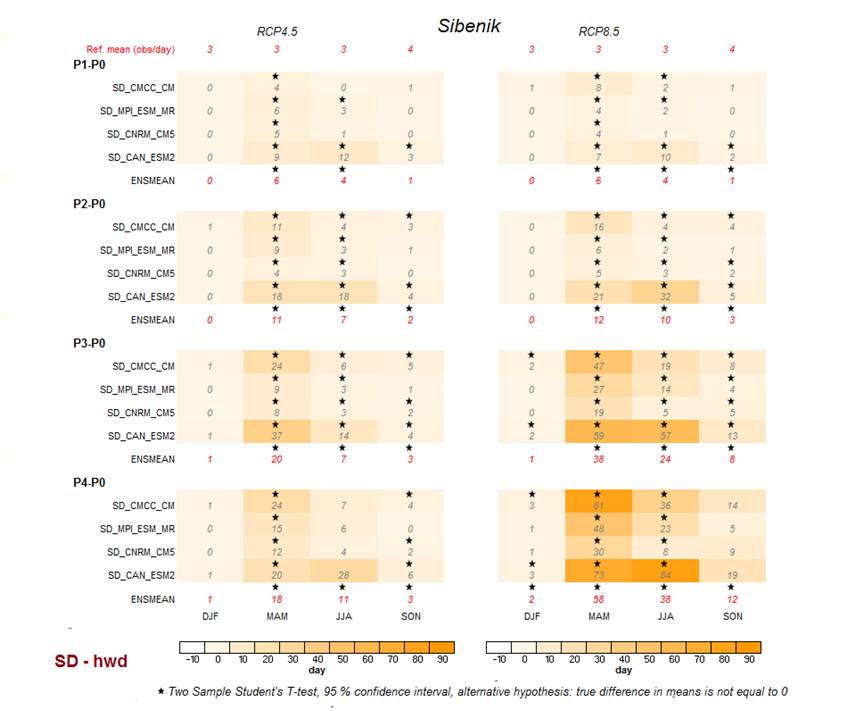
Figure 3: Seasonal heat wave duration: observed values over the reference period (in red), changes projected by statistical downscaling applied to 4GCMs and the Ensemble Mean of changes over the four periods (P1, P2, P3, P4) projected in the framework of RCP4.5 (left) and RCP8.5 (right). A significant change is marked by a star (Source ArpaeSimc)
2.2.4 Tropical nights
The analysis of the number of summer nights in which daily minimum temperature remains above 20°C in Šibenik shows a significant prolongation of those periods. The number of added tropical nights varies between 20 and 40 for moderate climate scenario and between 20 to 48 days for a high-emissions scenario. An important signal is noted during autumn as well with an increase of up to 11 tropical nights more at the end of century for high-emissions scenario.
2.2.5 Frost days
The future projections of frost days, namely the number of days with a daily minimum temperature lower than 0°C, show a decrease during winter, spring and autumn. The signal is higher during the winter season, with values up to -10 days towards the end of the century in the moderate scenario and -13 days with high-emissions.
3 Precipitation related data
3.1 Results from dynamical downscaling (DD)
3.1.1 Averaged precipitation
Averaged precipitation obtained by dynamical downscaling is expressed in mm/day and its change in the future is shown as relative to the same reference period as for temperature. Precipitation is a much more variable parameter than temperature, therefore there is not a unique sign of change neither through the year nor from model to model (Figure 4). The change in the models mean for Šibenik shows, for the moderate climate scenario, an increase of precipitation in the cold part of the year at the end of the century (6.2 % in winter, 9.1 % in autumn) and decrease in the warm part (-1.8 % in spring, -7.4 % in summer); annually it indicates an increase of 3.0 %. For the high-emissions climate scenario, the seasonal change is much higher, precipitation will decrease in summer (-22.7 %) and increase in winter (11.8 %). On an annual scale, there is almost no change at the end of the century.
Figure 4: Averaged seasonal and annual precipitation obtained by dynamical downscaling for Šibenik: Ref. mean is 20 years simulated period (1986-2005) for the ensemble mean in mmday-1; P1-P0, P2-P0, P3-P0, P4-P0 are the changes (in %) in the future for following periods P1: 2021-2040, P2: 2041-2060, P3: 2061-2080, P4: 2081-2100. Differences are shown for individual models. A significant change is marked by a star. Change is also shown as ensemble mean (ENSMEAN), not tested for significance. The left column is for the moderate scenario and the right one for the high-emissions scenario.
3.1.2 Intense precipitation
The amounts of intense precipitation (defined by 95th percentile of precipitation) in Šibenik will increase in all seasons except summer. At the end of the century, the increase will be most pronounced in autumn for the moderate scenario (18.6 %) and in winter for high-emissions scenario (16.1 %). In summer, it will decrease by -1.2 % for moderate scenario and -24.8 % for the high-emissions scenario. On an annual scale, intense precipitation will increase, 8.1 % for moderate climate scenario and 5.7 % for the high-emissions scenario.
3.1.3 Extreme precipitation
Extreme precipitation, defined by 99th percentile of precipitation, in Šibenik shows the increase in spring, winter and autumn and on an annual scale. The increase ranges from 11.7 % in spring to 16.0 % in autumn and amounts 11.9 % for annual scale for the moderate scenario. If we keep on doing business-as-usual, the amount of extreme precipitation will grow by 30.3 % in winter and 17.3 % on an annual scale. In summer, extreme precipitation will decrease for both scenarios (-5.8 % for moderate, and -2.6 % for high-emissions scenario).
3.1.4 Surface relative humidity projections
Seasonal and annual change of mean surface relative humidity (Figure 5) is shown by two available model realisations. Differences in signal change from one to another model indicate the need to use multiple models to be able to find the conclusion about the change in relative humidity. The ensemble mean of surface relative humidity change in Šibenik shows a small increase at the end of 21st century in all seasons except summer, indicating that we will have slightly drier summers. The high-emissions scenario shows a decrease in summer by -6 %. On an annual scale, surface relative humidity will decrease by -1.4 % at the end of the century.
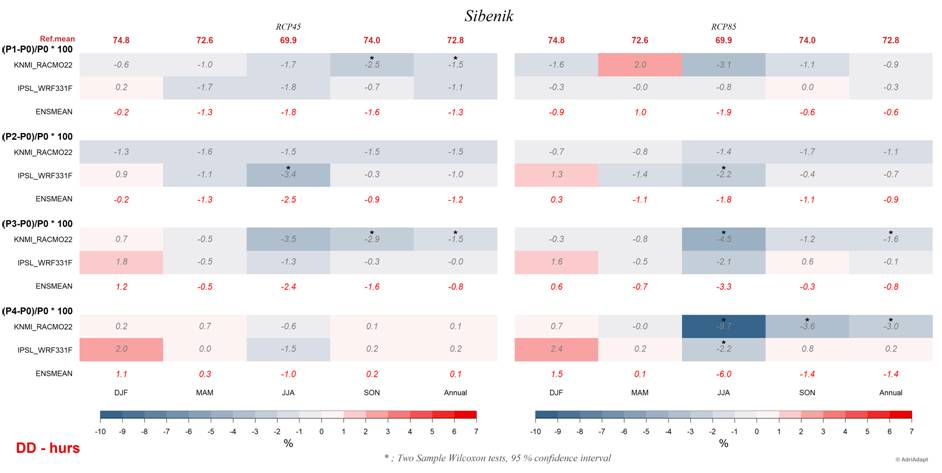
Figure 5: Seasonal and annual mean surface relative humidity (in %) obtained by dynamical downscaling for Šibenik: Ref. mean is a 20-year simulated period (1986-2005); P1-P0, P2-P0, P3-P0, P4-P0 are relative changes in the future for following periods P1: 2021-2040, P2: 2041-2060, P3: 2061-2080, P4: 2081-2100. Differences are shown for individual models. A significant change is marked by a star. Change is also shown as ensemble mean (ENSMEAN), not tested for significance. The left column is for moderate scenario and right for the high-emissions scenario.
3.2 Results from statistical downscaling (SD)
3.2.1 Amount of precipitation
The future change of precipitation obtained by statistical downscaling shows an overall decrease of precipitation. It will amount up to -28 % for moderate climate scenario and -40 % for high-emissions. A decrease of precipitation is more pronounced in summer, reaching -66 % in the framework of high-emissions scenario.
3.2.2 Intense precipitation
Intense precipitation, defined by 90th percentile of daily precipitation, shows for Šibenik significant increase for the summer season, up to 20 % for moderate climate scenario and up to 57 % for high-emissions climate scenario. Intense precipitation may become rarer during winter, spring and autumn.
3.2.3 Consecutive dry days
The consecutive dry days, defined as the maximum number of consecutive days without precipitation show for Šibenik shortening periods without rain during winter and a prolongation during spring, summer and autumn. The values of projected changes are generally significant, with a summer magnitude of +18 days for moderate climate scenario and +46 consecutive days for high-emissions climate scenario. Spring and autumn, the two agriculturally important seasons, can expect +17 days without rain in spring and +11 days in autumn for the high-emissions scenario.

